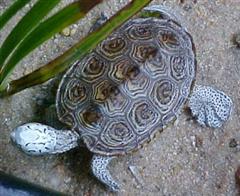Diamondback Terrapin
Chesapeake Terrapin Scientific Name: Malaclemys terrapin
Sat, 19th July, 2025 - 2:23 am GMT
Sponsor Ads:

Alternative Name
Chesapeake Terrapin Scientific Name: Malaclemys terrapinBasic Info
The Diamondback Terrapin is a moderately sized turtle characterized by the diamond-shaped, concentric markings on their upper shells. They are very handsome turtles. There are at least seven subspecies of the Diamondback Terrapin, which vary in markings and behavior. The Florida form of the Diamondback Terrapin is very dark gray-black and has a widened head and jaw that is used to eat barnacles off of mangrove trees. Besides the variety that exists between subspecies, a single turtle's coloration can change with age.
Health
Diamondback Terrapins should be kept in a large aquarium complete with areas to bask, filter systems and full spectrum UV lighting. Wild caught individuals require a saltwater environment with a minimum of a cup of salt for every 10 gallons. The specific gravity should be between 1.010 and 1.008. Water should be slightly acidic. It has been reported that captive born Diamondback Terrapins don't need salt in their water. Breeding Diamondback Terrapins prefer to lay their eggs in a scrape or burrow and so should be placed somewhere with a significant amount of substrate around laying time. Females will lay several clutches per year, usually beginning soon after hibernation and will continue laying about one clutch per month throughout much of the summer. Each clutch consists of several eggs. The ideal incubation temperature is 80 to 83 degrees Fahrenheit. The eggs usually incubate around 90 days before hatching.Habitat
Brackish water of salt marshesBehavior
The Diamondback Terrapin, also known as the "Chesapeake Terrapin", is an attractive and unique animal. It is the only North American turtle that can tolerate salt in its water. They are very popular among both novice and advanced herpetoculturists. While most turtles are freshwater species, the Diamondback Terrapin prefers the brackish water of salt marshes. Some of these marshes are fed by freshwater springs, while others are tidal, making the range of saltiness in which Diamondback Terrapins live quite large. Because Diamondback Terrapins will not live in polluted waters, they are a good indicator of healthy streams and marshes. The Diamondback Terrapin hibernates under the mud for several months in the winter, emerging in late May to mate, nest, and enjoy the sun.Origin
United StatesHistory
The Diamondback Terrapin is native to the Eastern and Southern United States, as far north as Cape Cod and as far south as the Florida Keys. Some Diamondbacks of varying subspecies may appear in regions outside their expected range, because of captive turtles that escaped or were released and influenced the local populations.Common Foods
N/ASponsor Ads:
"when you eliminate the impossible, whatever remains, however improbable, must be the truth." -- Sherlock Holmes
Diamondback Terrapin
Coded by: BGID® | ALL RIGHTS RESERVED Copyright © 2000-2025
Disclaimer | Privacy | Report Errors / Contact | Credits








 Preparing For China. China is growing their military. China Military Technology - can it keep up with the US?
Preparing For China. China is growing their military. China Military Technology - can it keep up with the US?  versus
versus 

 versus
versus 
 This Thread is about the North Korean Military itself - the kind of army, navy, and air force they have.
This Thread is about the North Korean Military itself - the kind of army, navy, and air force they have. 
 versus
versus 
 versus
versus  versus
versus